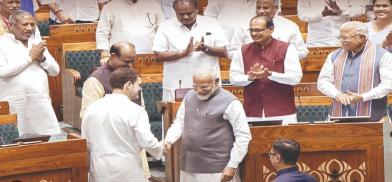In India’s changed polity, it is now clearly Narendra Modi versus Rahul Gandhi
Nearly 20 years Modi’s junior, Gandhi now has the opportunity to directly counterbalance a prime minister who for ten years since 2014 lorded over legislative actions because no opposition party had managed to win the required 10 per cent of the 543 parliamentary seats.

With his appointment as the leader of the opposition (LoP) in India’s parliament the Indian National Congress Party’s Rahul Gandhi has for the first time acquired a greatly consequential constitutional role.
In many ways the appointment, that puts him on par within parliament with Prime Minister Narendra Modi, will also subsequently test his political acumen unlike ever before.
Although it was never quite grounded in reality, the appointment also effectively silences the ruling Bharatiya Janata Party’s (BJP) derisive characterization of Gandhi as a “pappu” or a twit. Barely weeks ago, Modi had mockingly asked a broadcast journalist “Rahul kaun?” (Rahul, who?)
On Wednesday, when the 54-year-old Gandhi formally took over his position in parliament, the irony of that sobriquet was not lost on anyone when Modi shook his hand as a legislative equal. Being the LoP gives Gandhi a clearly defined constitutional role for the first time since he joined politics in 2004.
Counterbalance Modi
One of the consequences of becoming the leader of the opposition will be that he will sit on committees responsible for important national appointments such as the director of the country’s top law enforcement agency as well as the National Human Rights Commission.
Nearly 20 years Modi’s junior, Gandhi now has the opportunity to directly counterbalance a prime minister who for ten years since 2014 lorded over legislative actions because no opposition party had managed to win the required 10 per cent of the 543 parliamentary seats. In the latest election though the Congress Party nearly doubled its number from 52 to 99 seats making Gandhi eligible for the role.
Generally regarded as a reluctant politician for the better part of his nearly 25 years in politics, Gandhi underwent a dramatic transformation following his two cross-country marches that began in September 2022. The success of what was called ‘Bharat Jodo Yatra’ or United India March appeared to have infused a new vigor in Gandhi’s leadership style.
As the LoP, much rides on him from the standpoint of the Indian National Developmental Inclusive Alliance (INDIA) opposition coalition which now has 232 members in parliament. The coalition partners would look to Gandhi to maintain the momentum they found during the election campaigning.
There are expectations that Gandhi would lead from the front, making his presence felt every step of the way but at the same carefully navigating his legislative role keeping in mind his coalition partners.
Gandhi has been frequently criticized for his seemingly capricious and desultory approach to politics. However, since the cross-country marches, he has found a sharp focus by consistently raising political sensitive issues of corrupt crony capitalism, galloping unemployment, largescale impoverishment of ordinary Indians, farmers’ rights and ruptured societal relations along religious lines.
Seminal moment
As the LoP he will have to be both tactical and strategic within parliament as he seeks to not just enforce legislative checks and balances on Modi’s party but even push them on the defensive from time to time. The days of Modi and his parliamentary managers such as Home Minister Amit Shah riding roughshod over a scattered opposition of the last ten years are over for now.
In a video posted on the social media platform X today, he said he sees his position as the LoP as someone who represents the voice of India’s poor and marginalized. He called his role as their “auzar” or instrument. “Whatever your problems and sentiments, I will raise them in parliament,” he said.
“The constitution protects. Wherever the government attacks the constitution or tries to suppress it we will protect it with our full commitment,” he said.
Both his Congress Party and the broader INDIA grouping have framed their significantly improved electoral performance as a triumph of constitutionalism. A lot of opposition Members of Parliament carry pocket size copies of India’s constitution and wave at the treasury benches, the side of the house where the ruling party members sit.
Gandhi’s rise is widely seen as a seminal moment in India’s polity which has since 2014 been dominated by just one figure, namely Modi. Now the political landscape is clearly, if not evenly, divided between Modi and Gandhi.
(The writer is a Chicago based journalist, author and filmmaker. Views are personal. By special arrangement with Indica)










Post a Comment